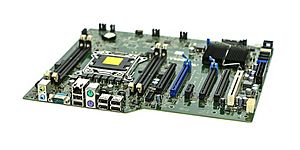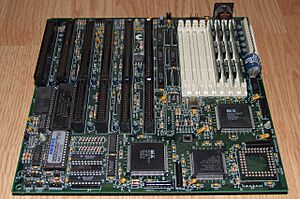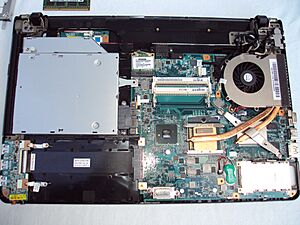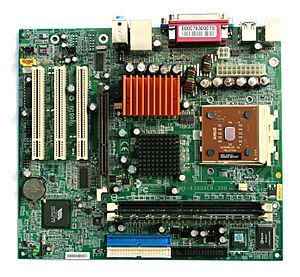Motherboard facts for kids
A motherboard is like the main brain and nervous system of a computer. It's a large electronic board that connects all the important parts of a computer, like the central processing unit (CPU), which is the computer's brain, and the memory, which helps it remember things.
Think of it as the "mother" board because it holds and lets all the other parts talk to each other. These parts can include sound cards, video cards, and network cards. Sometimes, motherboards are also called mainboards or logic boards (especially in Apple computers).
Some devices, like laser printers or mobile phones, have a "mainboard" that doesn't allow for many extra parts to be added. But a true "motherboard" is designed so you can add more parts later, making your computer more powerful or able to do new things.
Contents
How Motherboards Changed Over Time
Before microprocessors (the tiny computer brains) were invented, computers were huge! Their main parts, like the CPU and memory, were on many separate circuit boards. These boards would plug into a larger board called a backplane, which had wires connecting everything.
In the 1970s, when microprocessors became common, the CPU and some other parts could fit on one board. But memory and other devices still needed their own separate boards, all plugging into a backplane.
Early Personal Computers
By the 1980s, popular computers like the Apple II and IBM PC started putting more and more parts directly onto the motherboard. This made computers smaller and easier to build. People could even buy new motherboards to upgrade their computers, making them faster or adding new features.
As time went on, even more parts moved onto the motherboard. In the late 1980s, motherboards started including chips that handled things like the keyboard and mouse, floppy disk drives, and serial ports.
By the late 1990s, many motherboards had built-in sound, video, storage, and internet connections. This meant you didn't always need to buy separate expansion cards for these things. However, powerful computers for 3D gaming often still used separate, high-performance graphics cards.
Motherboards in Laptops and Small Devices
When laptops became popular in the 1990s, they needed motherboards that were very small and had most parts built right in. This is why it's often harder and more expensive to upgrade or fix laptops compared to desktop computers. Newer small devices like tablet computers and netbooks also have highly integrated motherboards, where memory, processors, and storage are often directly attached.
How a Motherboard is Designed
A motherboard is like the central hub for all the computer's electrical connections. It allows different parts to send information to each other. Unlike a simple backplane, a motherboard also holds the main brain (CPU) and other important systems.
A typical desktop computer has its microprocessor, main memory, and other key parts plugged into the motherboard. Other devices, like external storage drives or video and sound controllers, can be plugged in as cards or connected with cables. Today, many of these extra parts are often built directly into the motherboard itself.
An important part of the motherboard is the chipset. This is a group of chips that helps the CPU talk to the memory and other parts of the computer. The chipset largely decides what features and abilities the motherboard will have.
Key Parts of Modern Motherboards
Modern motherboards include several important features:
- CPU sockets: These are special spots where the microprocessor (CPU) is installed. Some CPUs are even soldered directly onto the board.
- Memory slots: These are where you install the computer's main memory (RAM) modules, like DDR4 or DDR5.
- Chipset: This acts as a translator, helping the CPU communicate with the main memory and other devices.
- Non-volatile memory chips: These chips (often flash memory) store the computer's basic instructions, called firmware or BIOS, which help it start up.
- Clock generator: This creates a steady beat (clock signal) that keeps all the computer's parts working in sync.
- Expansion slots: These are openings where you can plug in extra expansion cards, like a powerful graphics card.
- Power connectors: These bring electricity from the computer's power supply to all the parts on the motherboard. Some powerful graphics cards need their own direct power connection.
- Connectors for storage: These are used to connect hard disk drives, optical drives, or solid-state drives (SSDs), usually using SATA or NVMe connections.
Most motherboards also have connections for common input devices like USB for mice and keyboards. Older computers like the Apple II only had very basic connections on the motherboard, and you had to add cards for things like disk drives.
Because high-speed CPUs and other parts get very hot, modern motherboards almost always have heat sinks (metal blocks that absorb heat) and places to attach fans to cool them down.
Motherboard Sizes (Form Factors)
Motherboards come in different sizes and shapes, called form factors. Some are made only for specific computer brands. However, motherboards for IBM-compatible computers are designed to fit different case sizes.
Most desktop computer motherboards today use the ATX standard size. It's important that your computer case, motherboard, and power supply all match in size. Smaller motherboards, like microATX, can usually fit into larger ATX cases. Laptops use very small, custom-made motherboards, which is why they are harder to upgrade or fix.
CPU Sockets
A CPU socket is a special connector on the motherboard where the CPU (microprocessor) sits. It holds the CPU in place, helps cool it, and connects it electrically to the rest of the motherboard. CPU sockets are common in most desktop and server computers. The type of CPU socket on your motherboard must match the CPU you want to use.
Built-in Peripherals
As electronic parts have become smaller and cheaper, many peripherals (extra devices) can now be built directly onto the motherboard. This helps make computers smaller and less expensive. Highly integrated motherboards are popular in small and budget-friendly computers.
Here are some common built-in peripherals:
- Disk controllers: For connecting SATA drives and older PATA drives.
- Integrated graphics controller: This handles the computer's display, allowing you to connect monitors using VGA, DVI, HDMI, or DisplayPort.
- Integrated sound card: For playing audio, often supporting surround sound.
- Ethernet network controller: For connecting to a local network or the Internet using a cable.
- USB controller: For connecting USB devices like flash drives, printers, and cameras.
- Wireless network interface controller: For connecting to Wi-Fi networks.
- Bluetooth controller: For connecting wireless devices like headphones or keyboards.
- Sensors: These monitor the temperature, voltage, and fan speeds inside the computer to make sure everything is running smoothly.
Slots for Expansion Cards
A motherboard will have different numbers and types of slots for adding extra cards, depending on its size and standard.
A typical modern ATX motherboard usually has two or three PCI-Express x16 slots for powerful graphics cards. It might also have one or two older PCI slots for other expansion cards, and one or two PCI-E x1 slots.
Some motherboards have multiple PCI-E x16 slots. This allows you to use more than one graphics card at a time with special technologies like SLI (for Nvidia) or Crossfire (for AMD). This can give you much better performance for demanding tasks like gaming or video editing.
Newer motherboards also have M.2 slots, which are often used for very fast SSDs or wireless network cards.
Keeping Motherboards Cool and Reliable
Motherboards usually need to be cooled by air, with heat sinks often placed on the larger chips. If a computer doesn't have enough cooling, its parts can get damaged or the computer might crash. In the past, a single fan in the power supply was enough for many CPUs. But today, most CPUs need their own CPU fans on top of heat sinks because they generate a lot of heat.
Most motherboards have connectors for extra computer fans and built-in temperature sensors. The computer's BIOS (basic input/output system) or operating system can use these to control the fan speeds, keeping things cool. Some computers even use water cooling systems instead of many fans.
Some small computers, like those for home theaters, are designed to be very quiet and energy-efficient. They might not even have fans! This requires using a low-power CPU and carefully arranging the motherboard parts so that heat sinks can cool them properly.
In the early 2000s, some computer crashes were linked to old or faulty capacitors on motherboards. Capacitors are electronic parts that store and release electricity. If they don't work right, they can cause problems. Modern motherboards use better capacitors that last longer, especially if the computer is kept cool. Good cooling can significantly extend the life of a motherboard.
How a Computer Starts Up (Bootstrapping)
Motherboards have a special chip that stores basic instructions called firmware (or BIOS/UEFI in modern computers). This firmware helps the computer start up and load the operating system from a storage device. The term "bootstrapping" or "booting" comes from the idea of "lifting yourself by your bootstraps."
When you turn on your computer, the CPU first loads instructions from this special chip. These instructions tell the computer to:
- Check and set up all the hardware devices.
- Display system information on the screen.
- Test the RAM.
- Try to load the operating system (like Windows or macOS) from a hard drive or other storage.
This process of checking and setting up hardware when the computer turns on is called the Power-On Self Test (POST). The POST checks many things, including:
- The Video card
- Any expansion cards you've added
- Temperatures, voltages, and fan speeds
- The CMOS memory (which stores your BIOS settings)
- The keyboard and mouse
- The Sound card
- The network adapter
- Optical drives (like CD-ROM or DVD-ROM)
- Hard disk drives and solid-state drives
- USB devices
If the computer can't find an operating system, it might try to run a basic program stored in its ROM (like an old version of BASIC) or show an error message. Modern computers use either BIOS or UEFI to manage this startup process. UEFI is a newer system that became popular after Microsoft required it for computers running Windows 8.
See also
 In Spanish: Placa base para niños
In Spanish: Placa base para niños
- Accelerated Graphics Port (AGP)
- Basic Input/Output System (BIOS)
- Chip creep
- CMOS battery
- Computer case screws
- Expansion card
- List of computer hardware manufacturers
- M.2
- Overclocking
- Peripheral Component Interconnect (PCI)
- PCI-X
- PCI Express (PCIe)
- Single-board computer
- Switched-mode power supply#Applications
- Symmetric multiprocessing
- System on a chip
- U.2
- UEFI (Unified Extensible Firmware Interface)







